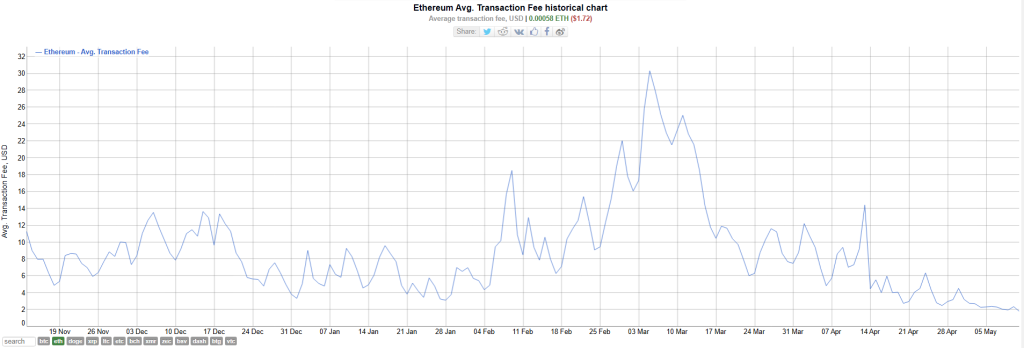Ethereum users are rejoicing over a dramatic drop in gas fees, with the network experiencing its lowest point since early 2020. This translates into significantly cheaper transactions, making the platform more accessible for everyday users and developers. However, experts caution that this fee fiesta might be temporary, raising questions about the long-term health of the network.
Ethereum Gas Prices Hit Rock Bottom
Data from from BitInfoCharts shows intraday gas fees dropping 93% from the peak of $30 just six months ago. This translates to a significant cost reduction for various activities on the Ethereum blockchain. Simple asset swaps now cost around $5, while minting NFTs has become a much more affordable endeavor at roughly $9.
This newfound affordability is attributed to a confluence of factors. The recent Cancun-Deneb upgrade is believed to have played a role in optimizing network efficiency. Additionally, a general downturn in network activity coincides with a calmer period in the broader cryptocurrency market.

A Boon For Users, But A Challenge For Miners
While users are celebrating the lower fees, concerns linger about the long-term sustainability of this trend. The near-zero “blob fee” suggests a lack of demand for block space, raising the specter of future congestion and fee spikes. Additionally, lower fees could negatively impact the profitability of miners who secure the Ethereum network.
According to analysts, this situation is a double-edged sword. While lower fees are great for users, they could make it more economical for large players to dominate block space, hindering decentralization.
The Quest For Scalability: Enter Multi-Dimensional Gas
The recent gas fee developments highlight the ongoing struggle to optimize Ethereum’s scalability and affordability. In response to these challenges, Vitalik Buterin, the platform’s founder, has proposed a significant upgrade introducing the concept of “multi-dimensional gas.”
This upgrade aims to provide Ethereum with greater flexibility in managing various resources. By taking a more nuanced approach to resource allocation, the network could potentially improve transaction throughput without compromising security.
A Look Ahead: Will Ethereum Maintain Its Momentum?
The dramatic drop in gas fees serves as a welcome respite for Ethereum users. However, the long-term viability of these low fees remains uncertain. The network’s ability to handle future surges in demand and maintain a healthy balance between user experience, miner profitability, and decentralization will be crucial for its continued success.
The proposed multi-dimensional gas mechanism embodies the ongoing efforts to address these challenges. As the Ethereum ecosystem continues to evolve, its ability to adapt and innovate will determine its position in the ever-changing landscape of blockchain technology.
Featured image from AutoDeal, chart from TradingView








